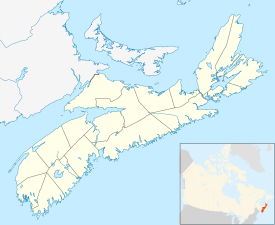Port La Tour, Nova Scotia
| Port La Tour | |
|---|---|
| Community | |
| Location of Port La Tour, Nova Scotia | |
| Coordinates: 43°29′50″N 65°28′29″W / 43.497222°N 65.474722°W | |
| Country |
|
| Province |
|
| County | Shelburne |
| Municipal district | Barrington |
| Time zone | AST (UTC-4) |
| • Summer (DST) | ADT (UTC-3) |
| Postal code(s) | B0W 2T0 |
| Area code(s) | 902 |
Port La Tour is a community in the Canadian province of Nova Scotia, located in the Barrington Municipal District of Shelburne County.
The Historic Sites and Monuments Board of Canada asserts that Fort Saint Louis is located at Port La Tour, although this has been disputed. It has also been claimed that the fort at Port La Tour was Fort Lomeron (also known as Fort La Tour) and that Fort St. Louis was located at the neighbouring community of Villagedale, Nova Scotia.
Cape Sable and Cape Negro, Nova Scotia were first settled by the Acadians who migrated from Port Royal, Nova Scotia in 1620. The French governor of Acadia, Charles de la Tour, colonized Cap de Sable giving it the present name, meaning Sandy Cape. La Tour built up a strong post at Cap de Sable (present-day Port La Tour, Nova Scotia) beginning in 1623, called Fort Lomeron in honour of David Lomeron who was his agent in France. (The fur trading post called Fort Lomeron was later renamed Fort La Tour although - erroneously - identified as Fort Saint-Louis in the writings of Samuel de Champlain.) Here he carried on a sizable trade in furs with the Mi'kmaq and farmed the land.
During the Anglo-French War (1627–1629), under Charles I, by 1629 the Kirkes took Quebec City, Sir James Stewart of Killeith, Lord Ochiltree planted a colony on Cape Breton Island at Baleine, and Alexander’s son, William Alexander, 1st Earl of Stirling established the first incarnation of “New Scotland” at Port Royal, Nova Scotia. This set of British triumphs in what had otherwise been a disastrous war was not destined to last. King Charles’ haste to make peace with France on the terms most beneficial to him meant that the new North American gains would be bargained away in the Treaty of Saint-Germain-en-Laye (1632). There were three battles in Nova Scotia during the colonization of Scots: one at Saint John; another battle at Balene, Cape Breton; and one on Cape Sable (Port La Tour).
...
Wikipedia

